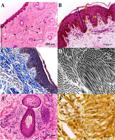ABSTRACT
The cryopreservation of somatic tissue derived from skin of collared peccaries is an alternative for biodiversity conservation through association with nuclear transfer. In this context, tissue manipulation of skin is a critical step for the success of this biotechnique. Therefore, the aim was to characterize the peripheral ear integumentary system derived from collared peccaries, directing to improve tissue conservation. Thus, ear fragments of eight animals were evaluated for tissue layers, components, proliferative activity and metabolic viability, using hematoxylin-eosin and Gomori Trichrome, AgNORs quantification and transmission electronic microscopy. Hence, sizes of 104.2 µm and 222.6 µm were observed in the epidermis and dermis, with a volumetric ratio of 36.6% and 58.7%, respectively. Moreover, basal layer (22.5 µm), intermediate (53.5 µm) and cornea (28.2 µm), with mean values of 65.3 epidermal cells, 43.4 melanocytes and 14.8 perinuclear halos were evidenced in the epidermal. Already the dermis has 127 fibroblasts with 2.5 AgNORs/nucleolus. Additionally, the metabolic activity was 0.243. In conclusion, the peripheral ear integumentary system derived from collared peccaries possessed some important variations compared to other mammals, as the number of layers and thickness of the epidermis, number of epidermal cells, melanocytes and proliferative parameters.
Keywords:
wild animals; histological evaluation; cell quantification

 Thumbnail
Thumbnail
 Thumbnail
Thumbnail

